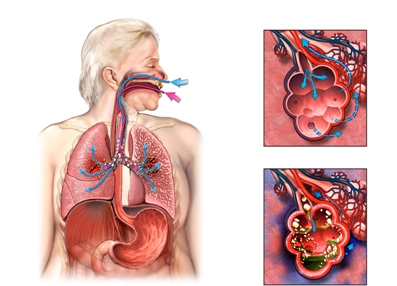Aspiration Pneumonia
Cm. also Pneumonia
Description of aspiration pneumonia
Aspiration pneumonia is an infection of the lungs, which develops after getting food, fluids or stomach contents into the lungs.
Causes aspiration pneumonia
Food and fluid pass down the esophagus into the stomach. Air enters through the mouth or nose and respiratory tract (windpipe) into the lungs. But the products, fluid or vomiting of stomach contents may accidentally get into the airways and lungs. This process is called aspiration.

Most people have a cough, to prevent, to debris caught in the lungs. But, some people are not able to clear the lungs cough. This can occur, when they are unconscious or if they have difficulties in swallowing food and liquids. Once the foreign matter into the lungs, they can cause infection, known as aspiration pneumonia.
Risk factors
The following factors increase the chance of developing aspiration pneumonia. Generally, elderly people with lung disease or stroke, having dental problems are most at risk.
- Loss of consciousness due to alcohol, seizures, stroke or other diseases;
- Violation of swallowing function due to poor teeth or Parkinson's disease, Lou Gehrig's disease, stroke or other diseases;
- Heartburn;
- Lung Diseases.
The symptoms of aspiration pneumonia
These symptoms may be caused not only by aspiration pneumonia, and other serious illnesses. When they occur, seek medical advice.
- Swallowing problems;
- Frequent coughing, especially after eating and / or drinking;
- Shortness of breath or loud breathing;
- Cardiopalmus;
- Fever;
- Chest pain, especially when coughing.
Diagnosis of aspiration pneumonia
The doctor asks about the symptoms and medical history, and performs a physical exam. During the examination, the doctor listens to the heart and lungs stethoscope. Tests may include the following:
- Chest X-ray – determines, whether there is infiltration within the lungs, which may be a symptom of infection;
- Sputum Culture – sputum (slizistopodobnaya secretion from the lungs) It can be tested, to determine, which antibiotic should be used for treatment;
- Bronchoscopy – tube with a camera at the end may be inserted through the nose or mouth into the airways, to obtain a sample of sputum and to inspect the airways;
- Radiopaque barium study – if you have problems with swallowing the doctor can see on the x-ray light aspiration.
Treatment of aspiration pneumonia
Treatment options include:
Antibiotics
Antibiotics are used, to treat aspiration pneumonia. In some cases, the patient must go to hospital, to introduce antibiotics directly through an intravenous catheter. In other cases, antibiotics taken orally (in the form of tablets or liquids).
Artificial respiration
In severe cases, aspiration pneumonia causes breathing problems. The patient may be connected to a respirator.
Prevention of aspiration pneumonia
To reduce the probability of occurrence of aspiration pneumonia, you must take the following steps:
- Follow the instructions of the doctor and not to eat anything before the surgery. This reduces the likelihood, that while in anesthetized stomach contents fall into the respiratory tract and cause pneumonia;
- If you have problems with swallowing specialist can offer the patient to change the shape of the reception food – eating a powdered form or in the form of puree. In severe cases, you may need to avoid eating foods and fluids by mouth. For special feeding tube into the stomach or intestines and the composition applied thereon for parenteral feeding.
